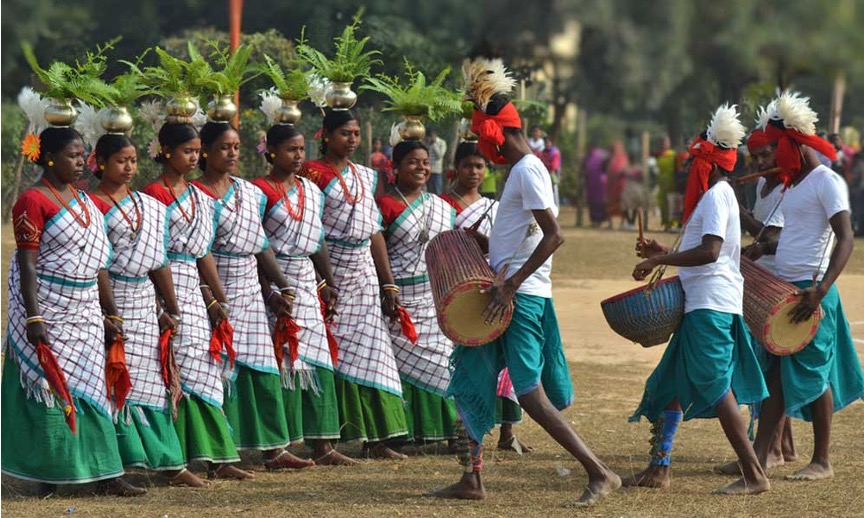Tribe: Santhal
Location: Jharkhand, West Bengal
The Santhal tribe is one of the largest indigenous tribes of India, with a population of around six million. They are found predominantly in the states of West Bengal, Jharkhand, Orissa, Bihar and Assam. They have a rich culture with their own distinct language, festivals, cuisine, music and art. They are very close to nature, and in the past, the tribes have lived in the forest.
 Santhali dance during a local festival
Santhali dance during a local festival
Location
The Santhals are mainly found in eastern Indian states in the following areas:
Jharkhand: The Chhota Nagpur plateau region, primarily concentrated in the districts of Dumka, Pakur and Sahebganj.
West Bengal: The districts of Purulia, Bankura, and West Midnapore.
Orissa: The districts of Mayurbhanj, Keonjhar, and Sundargarh.
Bihar: The regions of Jamui, Bhagalpur, and Banka.
Assam: Dibrugarh, Tinsukia, and Sivasagar.
Today, the Santhals live in both rural and urban areas. Traditionally, the tribe was found in remote and forested area, where the terrain is rugged and hilly like the Chhota Napgur plateau. There are over three million Santhals in Jharkhand alone.
 Where Santhals can be found in India
Where Santhals can be found in India
History
It is believed that the Santhals migrated from central India to eastern India. In recorded history, it is noted that the tribe had a conflict with the British while the latter was trying to get control over their region in West Bengal. In 1855, a Santhal Rebellion took place against the British led by their leader Sidhu. They were revolting against the unfair taxation imposed by the British on the Santhal community.

Culture
The Santhals are a forest-dwelling community with a deep connection with nature. They practice farming, hunting, fishing, and other nature related commercial activities. Each Santhali village is run by a council of elders called “Manjhis”.
Their language, Santhali, is one of the oldest languages in the world.
Santhals are also known for their vibrant music and dance. In one Santhali dance, women in traditional clothes clasp their hands around each other’s waists, form a queue, and have a synchronized set of steps going backwards and forward.
The Santhal festivals are closely linked to nature. Their main festivals are called Baha and Sohraee, also known as Bandhaa. The Sohraee festival is celebrated when the harvest season begins. This is one of their largest festivals and there’s lots of celebration in the community with rice beer and food. The Baha festival is held in spring and commemorates the blossoms of the Sal tree. Santhals worship the Sal leaves and flowers during this festival. As with all Santhal festivals, there is singing, dancing and celebrations tied to worship of nature.
Santhals worship a variety of gods and goddesses. Marang Buru, who is believed to be the creator and the most powerful god, is worshiped in many of their festivals.
Many Santhals display vibrant art in their colorful homes. Their houses are usually made of clay and cow dung with tiled roofs. They are decorated with colorful designs made with rice flour paste, called alpanas.
A common Santhal food is maad bhaat, a starchy fermented rice preparation eaten with pickle, onions, and green chillies.
 Traditional clothing of the Santhalis
Traditional clothing of the Santhalis
